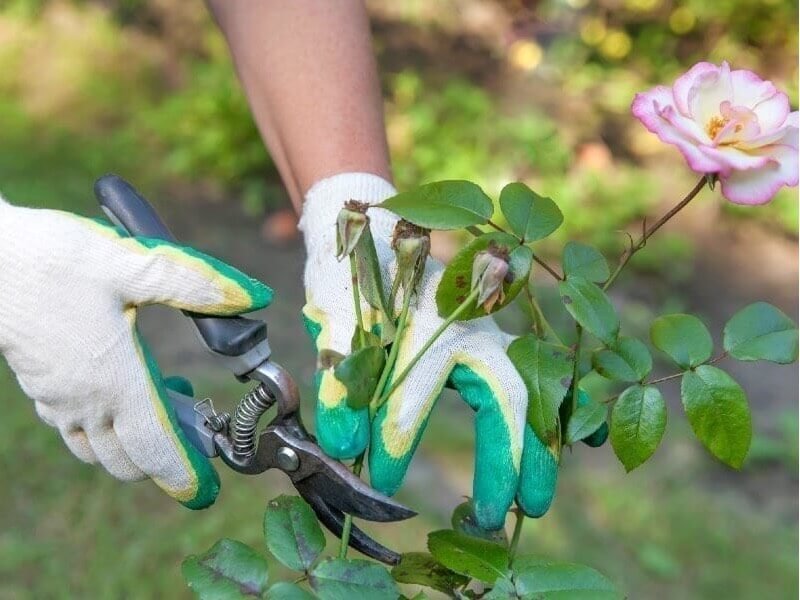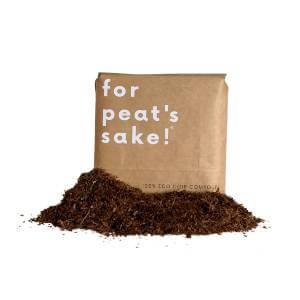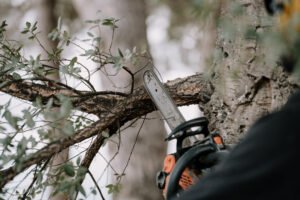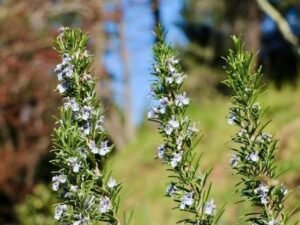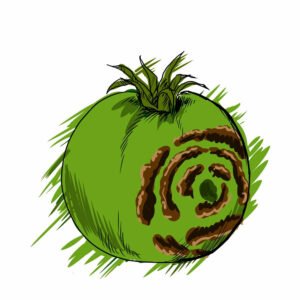You may notice that some varieties are described as “disease-resistant”, which means they will remain free from attack under ordinary conditions, but under epidemic conditions, preventatives will be necessary.
These varieties are resistant, not immune! Checking out the care and maintenance of your roses is an excellent option to help prevent diseases, as a healthy, vigorous plant is less susceptible to diseases.
Rust Disease
Although rust is not common when this disease strikes, it is often fatal! Rust is most likely to take over when there is typically a shortage of potash.
A cold spring followed by a dry summer and a hard winter will also encourage this disease to form. Rust disease is typically seen in mid-to-late summer and autumn.
How to spot if your roses have Rust Disease
- This disease will usually start as pale leaf spots; these will then develop into spore-producing or swellings (pustules).
- The leaves’ swelling can be an orange/rusty brown which during August will turn black on the underside of the leaves; sometimes these pustules can be black white or yellow. In some cases there could be thousands of these on one leaf.
- You will find these typically on the lower leaf surface.
- New shoots will turn a reddish colour and shrivel.
- This will usually attack in time for July.
- Heavily infected leaves can yellow and fall prematurely.
The solution to Rust Disease
In extreme cases, and in particular, if left untreated can kill your plant; this is due to it reducing the plant’s vigour.
- The disease can be slowed down by picking off affected leaves. If your plant is heavily infected we would not suggest taking off many leaves as this can ultimately do more harm than good.
- Provanto Fungus Fighter Concentrate – is a good option particularly for ornamental roses (always check the label before using it).
- Roseclear Ultra and Roseclear Ultra Gun are great options for controlling pests (always check the label before using).
Mildew
Mildew is the most widespread disease amongst roses and caused by the fungus Podosphaera pannosa. Closed-in conditions, dryness of roots, poor feeding, and hot days followed by cold nights are a few examples of why your roses may contract Mildew.
How to spot if your roses have Mildew
- You will notice a white powdery mould on the leaves and the buds. Sometimes it can found on the stem.
- This white growth can be found on both the upper and lower side of the leaf.
- Discolouration may be present on the leaves; this can be yellow red or purple on affected parts of the leaf. As the mildew ages it may turn browner. Young leaves that are heavily affected may be distorted or curled.
- You may also find mildew growth on stems (often around thorns) and flower stalks usually thicker and more mate-like than the white powder on the leaves.
- Flower buds may fail to open.
- Premature leaf fall can take place.
- Will attack most predominantly during the months of March-August.
The solution to Mildew
- Before planting avoid choosing a dense area close to or against a wall. Check out the preferences of your specific roses on where they grow best here.
- Prune out and bin heavily infected leaves or stems – do not reuse these as composts.
- As dry roots are one of the causes ensure that you water regularly and provide good drainage. Drought-stress roses are more susceptible to this fungicide.
- Spray with fungicides during late summer/early autumn with several applications in humid weather and growing seasons. Provanto Fungus Fighter Concentrate/ Provanto Fungus Fighter Plus – are both excellent options particularly for ornamental roses (always check the label before using it).
- Roseclear Ultra and Roseclear Ultra Gun are great options for controlling pests (always check the label before using).
Black spot (Diplocarpon rosae)
Black spot is the most serve disease your roses can have. It spreads rapidly if not treated at the first chance. Heavy infestations will spread to the leaf buds and then onto the stems; this can cause the vigour to be significantly reduced, eventually dying back.
Potash shortage and warm, wet weather in the summer can invigorate this disease.
How to spot if your roses have Black Spot
- Large black spots with a yellow fringe or ragged feathery outline will be evident on the leaves’ upper surface. They may begin to drop even if parts are unaffected.
- Be mindful that sometimes the spots may be small and sometimes it may not have a yellow outline. However the leaves will still drop.
- Typically the disease will start on the lower leaves and then travel up.
- The badly infected plant may lose all its leaves will begin to fall off.
- Severe defoliation may also occur.
- On younger stems small black scabby lesions may appear.
The solution to Blackspot
- Collect and destroy any infected fallen leaves and destroy off them.
- As a preventative in late winter apply a thick layer of mulch around the affected plant’s base. Using mulch will prevent rain splashing on soil-borne spores on new growth.
- Although this is a preventative making your baking soda spray can also offer protection; dissolve one teaspoon of baking soda one teaspoon of hand soap and 2 pints of lukewarm water. Spray the leaves thoroughly.
- Neem oil is an excellent organic method to use as a preventative.
- Roseclear Ultra and Roseclear Ultra Gun are great options for controlling pests (always check the label before using).
- When treating fungicides spray in late summer/early autumn with several applications in humid weather and growing seasons. Provanto Fungus Fighter Concentrate/ Provanto Fungus Fighter Plus – are both excellent options particularly for ornamental roses (always check the label before using it).
Canker – (Coniothyrium)
Canker is a pathogenic fungus that will affect the stems; it enters the stems by a wound caused by an insect or disease or mechanical damage; therefore, it’s good to watch out when hoeing.
Although not typically complicated by the fungus disease, it can be pretty damaging whilst also negatively impacting the appearance of your roses.
How to spot if your roses have Canker
- At the base of the stem you will notice a distinct brown and sunken area.
- On the cane you may see black splotches.
- The edge of the Canker may be swollen and the bark cracked.
- It will most likely attack during the colder months.
The solution to Canker
If left untreated and the Canker enlarges and encircles the stem, the whole growth above the diseased area will sadly die.
- Cut off and burn all the diseased woods. Ensure that you dip the secateurs blades in methylated spirits after each use.
- Promoting vigorous and healthy growth will help keep Canker away.
- Apply a compound fertiliser – Toprose is a good example!
- Arbex – seal and heal is also a good solution which you can paint onto large cuts.
Die-back
Die-back is not a specific disease; it can be caused by frost damage, Canker at the stem’s base, waterlogging, Mildew or black spot.
Lack of potash, calcium, phosphates and boron are all common causes for die-back and can present themselves at any time of the year, so it’s always good to be on the lookout.
How to spot if your roses have Die-back
- The shoot tips will turn a brown colour; then shoots will die back.
- The progression will move from the tip of the plant and then steadily downwards.
- The result of a poor pruning technique will most likely be the die-back of a pruning stub which again will progress down the plant.
- In some cases you may notice fungal structures which can be tiny black fruiting bodies on the plant’s affected area.
- As a result of frost damage young shoots in spring will brown and die-back at the tips.
- As die-back progresses back this can affect twigs branches the main stem or even the whole plant although this results from various causes.
The solution to die-back
Unfortunately, there are no fungicides currently that will cure die-back, and the best way to protect your rose from die-back is to ensure that they have the best planting conditions you can check out here. Below are a few preventatives for you to keep in mind;
- Cut off the affected shoot (any dead or damaged wood) as soon as you notice die-back. This should be at a bud below the dead area.
- Avoid feeding in the autumn as this leads to first-sensitive and the production of unripe wood. Feeding in spring however is essential if die-back is a problem.
- When pruning ensure that cuts are finished cleanly and made immediately above an outward-facing bud and sloping away.
- It’s always good to look out for any week or cross branches during routine pruning.
Let's go Shopping...
Products Coming Soon!

